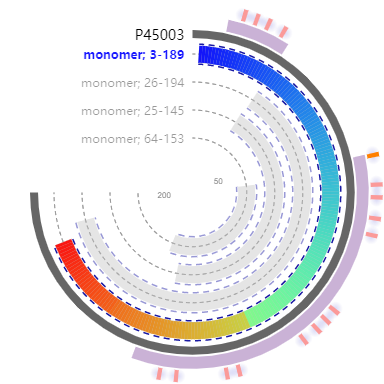Electron transfer subunit of the terminal reductase during anaerobic growth on various sulfoxide and N-oxide compounds.
MEQYGFYFDSERCTGCKTCELACKDYKDLGTEVNFRRIYEYTGGQWNQQADGCWHQNIFA
YYMSISCNHCADPACTKVCPTGAMHKNADGFVIVNEEICIGCRYCHMACPYDAPQYDAQK
GHMTKCDGCYSRVKSGQKPICVDACPLRALDFAPIDELRTKYGTQASIAPLPPTDITQPN
LVVKPNKYARLSGDTSGFLGNPREV208

| 10224050 | Interactions between the molybdenum cofactor and iron-sulfur clusters of Escherichia coli dimethylsulfoxide reductase.Rothery RA, Trieber CA, Weiner JH | We have used site-directed mutagenesis to study the interactions between the molybdo-bis(molybdopterin guanine dinucleotide) cofactor (Mo-bisMGD) and the other prosthetic groups of Escherichia coli Me2SO reductase (DmsABC). In redox-poised preparations, there is a significant spin-spin interaction between the reduced Em,7 = -120 mV [4Fe-4S] cluster of DmsB and the Mo(V) of the Mo-bisMGD of DmsA. This interaction is significantly modified in a DmsA-C38S mutant that contains a [3Fe-4S] cluster in DmsA, suggesting that the [3Fe-4S] cluster is in close juxtaposition to the vector connecting the Mo(V) and the Em,7 = -120 mV cluster of DmsB. In a DmsA-R77S mutant, the interaction is eliminated, indicating the importance of this residue in defining the interaction pathway. In ferricyanide-oxidized glycerol-inhibited DmsAC38SBC, there is no detectable interaction between the oxidized [3Fe-4S] cluster and the Mo-bisMGD, except for a minor broadening of the Mo(V) spectrum. In a double mutant, DmsAS176ABC102SC, which contains an engineered [3Fe-4S] cluster in DmsB, no significant paramagnetic interaction is detected between the oxidized [3Fe-4S] cluster and the Mo(V). These results have important implications for (i) understanding the magnetic interactions between the Mo(V) and other paramagnetic centers and (ii) delineating the electron transfer pathway from the [4Fe-4S] clusters of DmsB to the Mo-bisMGD of DmsA. | 1999 | |
| 0 | 3062312 | Nucleotide sequence of the dmsABC operon encoding the anaerobic dimethylsulphoxide reductase of Escherichia coli.Bilous PT, Cole ST, Anderson WF, Weiner JH | The tetrathionate (Ttr) and thiosulfate (Phs) reductases of Salmonella enterica LT2, together with the polysulfide reductase (Psr) of Wolinella succinogenes, are unusual examples of enzymes containing a molybdopterin active-site cofactor since all formally catalyse sulfur-sulfur bond cleavage. This is in contrast to the oxygen or hydrogen transfer reactions exhibited by other molybdopterin enzymes. Here the catalytic specificity of Ttr and Phs has been compared using both physiological and synthetic electron-donor systems. Ttr is shown to catalyse reduction of trithionate but not sulfur or thiosulfate. In contrast, Phs cannot reduce tetrathionate or trithionate but allows whole cells to utilize elemental sulfur as an electron acceptor. Mechanisms are proposed by which the bacterium is able to utilize an insoluble sulfur substrate by means of reactions at the cytoplasmic rather than the outer membrane. | 1988 |
Rothery R A , Trieber C A , Weiner J H . Interactions between the Molybdenum Cofactor and Iron-Sulfur Clusters of Escherichia coli Dimethylsulfoxide Reductase[J]. Journal of Biological Chemistry, 1999, 274(19):13002-13009.